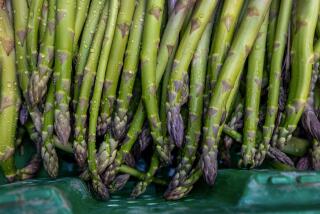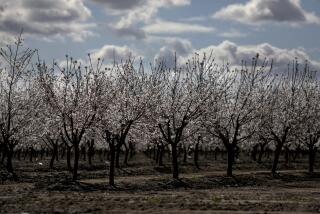Shellers Market
DAVENPORT, Calif. — In its long history, abalone has inspired passion, crime and deceit. Not bad for a humble shellfish.
Now, with the worldwide supply of wild abalone depleted by over-harvesting, coastal development and predatory sea otters, voracious demand for the sweet-tasting epicurean delight is also spawning a boomlet in abalone farming.
One company seeking to capitalize on the wildly out-of-balance situation is US Abalone, ensconced on a 4-acre site in this rural coastal community north of Santa Cruz. Here, in 50 plastic tanks filled with chilly seawater, US Abalone is raising tons of the kelp-eating, nocturnal mollusks for sale to U.S. distributors and area restaurants and to a burgeoning overseas market, particularly in Japan.
“It’s going to start snowballing,” said Tom Ebert, co-founder and president of US Abalone, which aspires to be the largest abalone farming company in the world and recently became the first California aquaculture venture to sell stock to the public. “We see this thing really starting to take off.”
Of course, starry-eyed investors have been saying that sort of thing for years. In the two-plus decades since the world rushed headlong into aquaculture, bankruptcies, bacterial epidemics and price upheaval have dampened much of the early enthusiasm. Those fish farmers who remain are, theoretically at least, a more realistic lot.
In the United States, despite the setbacks, farming the sea has indeed become a sizable industry. In 1993, U.S. aquaculture operations raised more than 715 million pounds of fish and recorded nearly $810 million in sales, according to the National Marine Fisheries Service. In addition to abalone, products include shrimp, salmon, catfish, trout, tilapia and oysters.
By California’s out-sized standards, the state’s contribution to the nation’s aquaculture appears paltry. Aquaculture here is worth about $60 million to growers, according to Bob Hulbrock, aquaculture coordinator at the state Department of Fish and Game in Sacramento. But the state has contributed significant technical innovations that have helped the industry grow.
Aquaculture remains, however, an industry for the stout of heart. Successful abalone farming, for example, requires tremendous outlays of capital for equipment, coastal sites and permits--and lots of patience. Red abalone, the largest of four species native to California and the one best suited to aquaculture, require 3 1/2 years to grow--at the rate of an inch per year--to the most desirable size.
Abalone farmers must also be willing to engage in frequent skirmishes with commercial fishermen and environmentalists, who worry about the effects of some sea-based farming operations.
California is responsible for nearly all the U.S. abalone harvest, but the fishery has been in steep decline for years. Gone are the days when passers-by could wade into the surf off Monterey and pluck abalone from the rocks.
From a peak of 5 million pounds of wild abalone harvested annually in the 1950s off the Golden State’s coast, the figure began plummeting in 1969. Now, just 260,000 pounds is harvested in the ocean. In some places, the fishery has disappeared; many abalone species are near extinction and are off-limits to recreational divers and commercial fishermen.
A variety of factors get the blame. Chief among them, the Department of Fish and Game notes, are the burgeoning population of sea otters, the key predator; over-harvesting and poaching; and coastal development and pollution, which have altered large areas of habitat.
As ocean supplies dwindle and demand increases, the prices paid for abalone are soaring. Live, farm-raised abalone in the shell ranges from about $16 to $24 a pound at wholesale. In the last year, the price has risen 10%.
All this spells opportunity for US Abalone, an 8-year-old company reputed to have one of the industry’s best technical teams.
Ebert’s co-founder is James R. Webb, chief executive and chief financial officer. Also on board are Ebert’s brother, Dave, a marine biologist, and their father, Earl, who devoted much of his 30 years at the Department of Fish and Game to getting the fledgling abalone farming industry going.
Under father Earl’s tutelage, the Ebert boys grew up diving for abalone. It got so that the family would eat the delicacy three or four nights a week, a bit much even for the mollusk-loving youngsters.
For the last six years, the Eberts have devoted seven days a week to their venture. “All of us have a passion,” said Dave Ebert. And the brothers still enjoy sneaking away for a day now and then to see who can hold his breath longer as they dive for the creatures.
They aren’t alone in their devotion. The ancient abalone is surrounded by an almost legendary mystique. Indians were eating abalone and using its ear-shaped, iridescent shell for implements and decoration long before Europeans arrived in North America.
In the late 1890s, according to Cabrillo College history instructor Sandy Lydon, Japanese marine biologists pioneered and dominated a deep-water abalone fishery off the Monterey peninsula, using hand-powered pumps to supply air to divers who pried or cut the shellfish from rocks. After 1942, when their boats were impounded and the Japanese were interned, the industry passed to other groups.
A German restaurateur is credited with expanding the appetite for abalone. In the early 1900s, the immigrant, Pop Ernst, was the first to pound abalone to make it thin and tender. He served an abalone stew in the shell at his Monterey restaurant that prompted satisfied customers to wax poetic in the eatery’s guest book.
“He is the reason people pay $60 a pound for abalone today,” said Tim Thomas, historian for the Monterey Maritime Museum.
Most abalone sold in the U.S. is destined for Chinese restaurants, Japanese sushi bars and a few upscale Western-style restaurants. Properly prepared, it has a silky texture and a buttery flavor. Most diners find abalone too expensive for an entree, but it makes a popular appetizer.
Over the years, rising prices have led to increased poaching and the occasional selling of below-market-size mollusks. Courts have taken a harsher stance of late, meting out jail terms and steep fines.
Breaking with the industry’s typically quiet ways, US Abalone last summer filed a prospectus disclosing financial details (so far it has operated at a loss) and began selling shares at $5 each directly to the public to gain capital for expansion. So many people expressed interest and visited its World Wide Web site (https://www.usabalone.com) that US Abalone felt obliged to open the farm to tours over a couple of recent weekends.
Visitors saw abalone in various stages of development, from hatchery to nursery to grow-out tanks. At night, the animals feed on kelp, harvested just offshore.
US Abalone has a ways to go to reach its lofty aspirations. Among half a dozen competitors along California’s coast, Abalone Farm, based in Cayucos on the Central Coast, has 10 times the capacity of US Abalone, although the latter is quickly adding tanks. Abalone Farm single-handedly accounts for about 40% of the state’s farmed abalone and, with more than 550 tanks, claims to be the nation’s largest producer as well.
Even for a large operation such as Abalone Farm, a big payoff has remained elusive. “It hasn’t proven to be a very profitable business yet,” said Ray Fields, president. “But there is definitely the potential for good profit.”
All told, abalone growers’ share of the state’s aquaculture industry is estimated at a minnow-esque $3.25 million. But Webb and the Eberts are encouraged by the potential.
“This is a big world,” Webb said, “with a big appetite for abalone.”
(BEGIN TEXT OF INFOBOX / INFOGRAPHIC)
Mollusk Matters
California is responsible for nearly all the nation’s abalone harvest. A look at this hard-to-find delicacy:
* What it is: An abalone is a one-shelled mollusk found in most mild and tropical seas. It is related to clams, scallops, octopuses and squid.
* Where it lives: The abalone prefers shallow waters and attaches itself to submerged rocks with its flat, muscular foot. It feeds on plants it scrapes off rocks with its tongue.
* Who harvests it: The primary suppliers of abalone worldwide are Australia, Japan, Mexico, New Zealand, South Africa and the United States *.
* Who eats it: Asia consumes the majority of the worldwide abalone supply, which commands prices of $60 to $80 a pound. Select restaurants sell abalone dishes for $20 to $55.
* Based on 1993 wild harvests.
Sources: US Abalone, World Book Encyclopedia, Times and wire reports
More to Read
Sign up for The Wild
We’ll help you find the best places to hike, bike and run, as well as the perfect silent spots for meditation and yoga.
You may occasionally receive promotional content from the Los Angeles Times.







